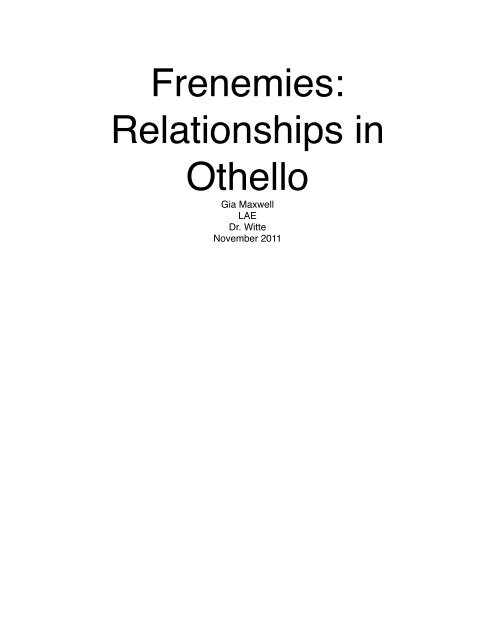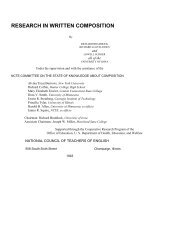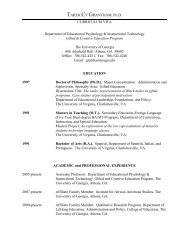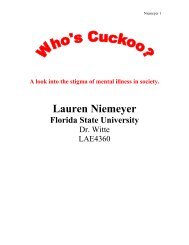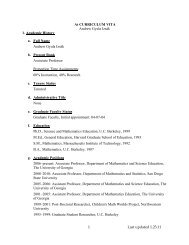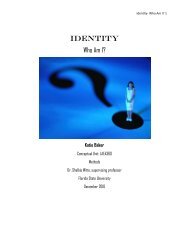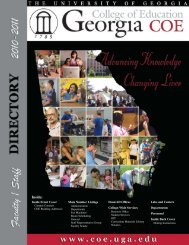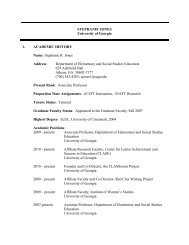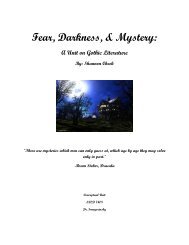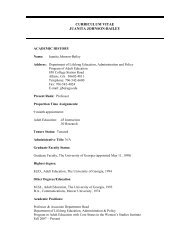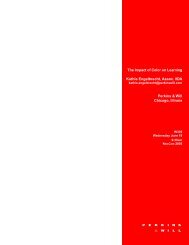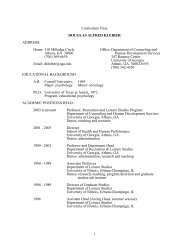Frenemies: Relationships in Othello - College of Education
Frenemies: Relationships in Othello - College of Education
Frenemies: Relationships in Othello - College of Education
You also want an ePaper? Increase the reach of your titles
YUMPU automatically turns print PDFs into web optimized ePapers that Google loves.
<strong>Frenemies</strong>:<br />
<strong>Relationships</strong> <strong>in</strong><br />
<strong>Othello</strong><br />
Gia Maxwell<br />
LAE<br />
Dr. Witte<br />
November 2011
Table <strong>of</strong> Contents<br />
Five Week Unit Plan ....................................................................................... 3<br />
! Rationale .............................................................................................. 3<br />
! Common Core Standards .................................................................... 5<br />
! Required Texts / Materials ................................................................... 8<br />
! Goals .................................................................................................... 8<br />
! Objectives.............................................................................................. 9<br />
! Daily Lesson Breakdown ..................................................................... 11<br />
Appendix ........................................................................................................ 26<br />
References ..................................................................................................... 35<br />
2
Rationale<br />
! Build<strong>in</strong>g relationship is an essential part <strong>of</strong> grow<strong>in</strong>g up and becom<strong>in</strong>g a better member<br />
<strong>of</strong> a community. The purpose <strong>of</strong> this unit is to help students better understand relationships and<br />
how they effect the <strong>in</strong>dividual through a classical text. Many different types <strong>of</strong> relationships are<br />
represented <strong>in</strong> William Shakespeare’s tragedy, <strong>Othello</strong>. One <strong>of</strong> the popular relationships is<br />
someth<strong>in</strong>g known as a “frenemy.” A frenemy is a friend who is also your greatest enemy. It<br />
takes the phrase “keep your friends close and your enemies closer” to a whole new level. The<br />
frenemy relationship I am referr<strong>in</strong>g to is that between <strong>Othello</strong> and Iago. Although they are best<br />
<strong>of</strong> friends at the start <strong>of</strong> the play, by the end they are mortal enemies, all the while <strong>Othello</strong><br />
hav<strong>in</strong>g no idea Iago had felt this way all along. Throughout the unit we will be analyz<strong>in</strong>g this<br />
and other relationships throughout the text and explore how these relationships differ and what<br />
we can learn from them. We will be touch<strong>in</strong>g on themes <strong>of</strong> honesty, love, loyalty, truth, and<br />
betrayal.<br />
! Although <strong>Othello</strong> is an archaic text, and many students struggle with the language, it is<br />
vitally important to their success as a educated reader. Many <strong>of</strong> the themes and archetypes we<br />
see <strong>in</strong> modern day were orig<strong>in</strong>ated by Wm. Shakespeare. See<strong>in</strong>g the transcendence <strong>in</strong><br />
literature and <strong>in</strong> life is essential to help<strong>in</strong>g students see past the life <strong>of</strong> a high school student.<br />
Although this lesson is suited for a tenth grade english course, it can easily be modified for any<br />
level <strong>of</strong> high school. Beyond the themes <strong>in</strong> the text and how they relate to the students, we will<br />
be look<strong>in</strong>g at language and its movement through the time. Discover<strong>in</strong>g why Wm.<br />
Shakespeare uses this language and how it affects the plot is a large aspect <strong>of</strong> study<strong>in</strong>g any<br />
Shakespeare text. These higher order critical th<strong>in</strong>k<strong>in</strong>g skills are skills that can easily be<br />
3
translated to standardized test<strong>in</strong>g such as the FCAT or SAT/ACT. Beyond the test, analyz<strong>in</strong>g<br />
and synthesiz<strong>in</strong>g <strong>in</strong>formation is a skill required for success <strong>in</strong> college and life.<br />
! Some <strong>of</strong> the supplementary materials used to scaffold the material are seem<strong>in</strong>gly<br />
unrelated, but prove to be a great catalyst for conversation and discovery. We will be view<strong>in</strong>g a<br />
short clip from the film Mean Girls, and later us<strong>in</strong>g relationships from pop culture to connect the<br />
text to current events. All supplementary materials have been viewed and approved by the<br />
proper sources to be shown <strong>in</strong> front <strong>of</strong> the students.<br />
! Aga<strong>in</strong>, the primary goal is to expand students world and allow them to see how<br />
relationships affect us, now and <strong>in</strong> the future. Do<strong>in</strong>g this through a classic text such as<br />
Shakespeare allows for a great deal <strong>of</strong> learn<strong>in</strong>g and reflect<strong>in</strong>g. Putt<strong>in</strong>g literature and life <strong>in</strong>to<br />
perspective is an essential skill and one that will result <strong>in</strong> students who are more aware and<br />
better world citizens.<br />
! There are several aspects <strong>of</strong> my classroom that are necessary to be able to pick up<br />
where I beg<strong>in</strong>. First <strong>of</strong> all, it was not my <strong>in</strong>tention to have this be the first unit <strong>in</strong> the semester.<br />
The unit before this would be some sort <strong>of</strong> <strong>in</strong>troduction to Shakespeare where they become<br />
familiar with the language and context. While this unit would cont<strong>in</strong>ue to show them how<br />
<strong>in</strong>vestigate Shakespeare’s works on their own, they would be scaffold<strong>in</strong>g what <strong>in</strong>formation they<br />
already know about Shakespeare. Some th<strong>in</strong>gs that speak to the organization <strong>of</strong> my classroom<br />
<strong>in</strong>clude the regular use <strong>of</strong> journals, the work baskets <strong>in</strong> the front <strong>of</strong> the room, and a culture <strong>of</strong><br />
open discussion. Journals <strong>in</strong> our classroom, are for do now’s and <strong>in</strong> class reflection. The work<br />
baskets are by my desk and are where all work is located; both make up and collections.<br />
4
Key Ideas and Details<br />
Common Core Standards<br />
• RL.9-10.1. Cite strong and thorough textual evidence to support analysis <strong>of</strong> what the<br />
text says explicitly as well as <strong>in</strong>ferences drawn from the text.<br />
• RL.9-10.2. Determ<strong>in</strong>e a theme or central idea <strong>of</strong> a text and analyze <strong>in</strong> detail its<br />
development over the course <strong>of</strong> the text, <strong>in</strong>clud<strong>in</strong>g how it emerges and is shaped and<br />
ref<strong>in</strong>ed by specific details; provide an objective summary <strong>of</strong> the text.<br />
• RL.9-10.3. Analyze how complex characters (e.g., those with multiple or conflict<strong>in</strong>g<br />
motivations) develop over the course <strong>of</strong> a text, <strong>in</strong>teract with other characters, and<br />
advance the plot or develop the theme.<br />
Craft and Structure<br />
• RL.9-10.4. Determ<strong>in</strong>e the mean<strong>in</strong>g <strong>of</strong> words and phrases as they are used <strong>in</strong> the text,<br />
<strong>in</strong>clud<strong>in</strong>g figurative and connotative mean<strong>in</strong>gs; analyze the cumulative impact <strong>of</strong> specific<br />
word choices on mean<strong>in</strong>g and tone (e.g., how the language evokes a sense <strong>of</strong> time and<br />
place; how it sets a formal or <strong>in</strong>formal tone).<br />
• RL.9-10.5. Analyze how an author’s choices concern<strong>in</strong>g how to structure a text, order<br />
events with<strong>in</strong> it (e.g., parallel plots), and manipulate time (e.g., pac<strong>in</strong>g, flashbacks)<br />
create such effects as mystery, tension, or surprise.<br />
• RL.9-10.6. Analyze a particular po<strong>in</strong>t <strong>of</strong> view or cultural experience reflected <strong>in</strong> a work <strong>of</strong><br />
literature from outside the United States, draw<strong>in</strong>g on a wide read<strong>in</strong>g <strong>of</strong> world literature.<br />
Integration <strong>of</strong> Knowledge and Ideas<br />
• RL.9-10.7. Analyze the representation <strong>of</strong> a subject or a key scene <strong>in</strong> two different artistic<br />
mediums, <strong>in</strong>clud<strong>in</strong>g what is emphasized or absent <strong>in</strong> each treatment (e.g., Auden’s<br />
“Musée des Beaux Arts” and Breughel’s Landscape with the Fall <strong>of</strong> Icarus).<br />
• RL.9-10.8. (Not applicable to literature)<br />
• RL.9-10.9. Analyze how an author draws on and transforms source material <strong>in</strong> a specific<br />
work (e.g., how Shakespeare treats a theme or topic from Ovid or the Bible or how a<br />
later author draws on a play by Shakespeare).<br />
Range <strong>of</strong> Read<strong>in</strong>g and Level <strong>of</strong> Text Complexity<br />
• RL.9-10.10. By the end <strong>of</strong> grade 9, read and comprehend literature, <strong>in</strong>clud<strong>in</strong>g stories,<br />
dramas, and poems, <strong>in</strong> the grades 9–10 text complexity band pr<strong>of</strong>iciently, with<br />
scaffold<strong>in</strong>g as needed at the high end <strong>of</strong> the range.<br />
Text Types and Purposes<br />
5
• W.9-10.2. Write <strong>in</strong>formative/explanatory texts to exam<strong>in</strong>e and convey complex ideas,<br />
concepts, and <strong>in</strong>formation clearly and accurately through the effective selection,<br />
organization, and analysis <strong>of</strong> content.<br />
◦ Introduce a topic; organize complex ideas, concepts, and <strong>in</strong>formation to make<br />
important connections and dist<strong>in</strong>ctions; <strong>in</strong>clude formatt<strong>in</strong>g (e.g., head<strong>in</strong>gs),<br />
graphics (e.g., figures, tables), and multimedia when useful to aid<strong>in</strong>g<br />
comprehension.<br />
◦ Develop the topic with well-chosen, relevant, and sufficient facts, extended<br />
def<strong>in</strong>itions, concrete details, quotations, or other <strong>in</strong>formation and examples<br />
appropriate to the audience’s knowledge <strong>of</strong> the topic.<br />
◦ Use appropriate and varied transitions to l<strong>in</strong>k the major sections <strong>of</strong> the text,<br />
create cohesion, and clarify the relationships among complex ideas and<br />
concepts.<br />
◦ Use precise language and doma<strong>in</strong>-specific vocabulary to manage the complexity<br />
<strong>of</strong> the topic.<br />
◦ Establish and ma<strong>in</strong>ta<strong>in</strong> a formal style and objective tone while attend<strong>in</strong>g to the<br />
norms and conventions <strong>of</strong> the discipl<strong>in</strong>e <strong>in</strong> which they are writ<strong>in</strong>g.<br />
◦ Provide a conclud<strong>in</strong>g statement or section that follows from and supports the<br />
<strong>in</strong>formation or explanation presented (e.g., articulat<strong>in</strong>g implications or the<br />
significance <strong>of</strong> the topic).<br />
Comprehension and Collaboration<br />
• SL.9-10.1. Initiate and participate effectively <strong>in</strong> a range <strong>of</strong> collaborative discussions<br />
(one-on-one, <strong>in</strong> groups, and teacher-led) with diverse partners on grades 9–10 topics,<br />
texts, and issues, build<strong>in</strong>g on others’ ideas and express<strong>in</strong>g their own clearly and<br />
persuasively.<br />
◦ Come to discussions prepared, hav<strong>in</strong>g read and researched material under<br />
study; explicitly draw on that preparation by referr<strong>in</strong>g to evidence from texts and<br />
other research on the topic or issue to stimulate a thoughtful, well-reasoned<br />
exchange <strong>of</strong> ideas.<br />
◦ Work with peers to set rules for collegial discussions and decision-mak<strong>in</strong>g (e.g.,<br />
<strong>in</strong>formal consensus, tak<strong>in</strong>g votes on key issues, presentation <strong>of</strong> alternate views),<br />
clear goals and deadl<strong>in</strong>es, and <strong>in</strong>dividual roles as needed.<br />
◦ Propel conversations by pos<strong>in</strong>g and respond<strong>in</strong>g to questions that relate the<br />
current discussion to broader themes or larger ideas; actively <strong>in</strong>corporate others<br />
<strong>in</strong>to the discussion; and clarify, verify, or challenge ideas and conclusions.<br />
◦ Respond thoughtfully to diverse perspectives, summarize po<strong>in</strong>ts <strong>of</strong> agreement<br />
and disagreement, and, when warranted, qualify or justify their own views and<br />
6
understand<strong>in</strong>g and make new connections <strong>in</strong> light <strong>of</strong> the evidence and reason<strong>in</strong>g<br />
presented.<br />
Vocabulary Acquisition and Use<br />
• L.9-10.4. Determ<strong>in</strong>e or clarify the mean<strong>in</strong>g <strong>of</strong> unknown and multiple-mean<strong>in</strong>g words and<br />
phrases based on grades 9–10 read<strong>in</strong>g and content, choos<strong>in</strong>g flexibly from a range <strong>of</strong><br />
strategies.<br />
◦ Use context (e.g., the overall mean<strong>in</strong>g <strong>of</strong> a sentence, paragraph, or text; a word’s<br />
position or function <strong>in</strong> a sentence) as a clue to the mean<strong>in</strong>g <strong>of</strong> a word or phrase.<br />
◦ Identify and correctly use patterns <strong>of</strong> word changes that <strong>in</strong>dicate different<br />
mean<strong>in</strong>gs or parts <strong>of</strong> speech (e.g., analyze, analysis, analytical; advocate,<br />
advocacy).<br />
◦ Consult general and specialized reference materials (e.g., dictionaries,<br />
glossaries, thesauruses), both pr<strong>in</strong>t and digital, to f<strong>in</strong>d the pronunciation <strong>of</strong> a<br />
word or determ<strong>in</strong>e or clarify its precise mean<strong>in</strong>g, its part <strong>of</strong> speech, or its<br />
etymology.<br />
◦ Verify the prelim<strong>in</strong>ary determ<strong>in</strong>ation <strong>of</strong> the mean<strong>in</strong>g <strong>of</strong> a word or phrase (e.g., by<br />
check<strong>in</strong>g the <strong>in</strong>ferred mean<strong>in</strong>g <strong>in</strong> context or <strong>in</strong> a dictionary).<br />
• L.9-10.5. Demonstrate understand<strong>in</strong>g <strong>of</strong> figurative language, word relationships, and<br />
nuances <strong>in</strong> word mean<strong>in</strong>gs.<br />
◦ Interpret figures <strong>of</strong> speech (e.g., euphemism, oxymoron) <strong>in</strong> context and analyze<br />
their role <strong>in</strong> the text.<br />
◦ Analyze nuances <strong>in</strong> the mean<strong>in</strong>g <strong>of</strong> words with similar denotations.<br />
• L.9-10.6. Acquire and use accurately general academic and doma<strong>in</strong>-specific words and<br />
phrases, sufficient for read<strong>in</strong>g, writ<strong>in</strong>g, speak<strong>in</strong>g, and listen<strong>in</strong>g at the college and career<br />
read<strong>in</strong>ess level; demonstrate <strong>in</strong>dependence <strong>in</strong> gather<strong>in</strong>g vocabulary knowledge when<br />
consider<strong>in</strong>g a word or phrase important to comprehension or expression.<br />
7
<strong>Othello</strong> by William Shakespeare<br />
Worksheets attached <strong>in</strong> the Appendix<br />
Videos attached <strong>in</strong> the Appendix<br />
Projector with A/V hook up available<br />
Required Texts / Materials<br />
Ipad’s with Elizabethan Insult Generator Application pre-downloaded<br />
1965 <strong>Othello</strong> film Directed by Stuart Burge<br />
Students will read the texts assigned<br />
Goals<br />
Students will complete all <strong>in</strong> and out <strong>of</strong> class work assigned<br />
Students will look to the text for reflection on relationships<br />
Students will form their own op<strong>in</strong>ions about relationships <strong>in</strong> their life and the text<br />
Students will recognize archetypes <strong>in</strong> relationships<br />
Students will ga<strong>in</strong> a broader view <strong>of</strong> relationships <strong>in</strong> their life and the text<br />
8
SWBAT:<br />
Objectives<br />
Argue an op<strong>in</strong>ion with legitimate and rationalized reason<strong>in</strong>g<br />
Recognize character traits<br />
Compare characters <strong>in</strong> a relationship<br />
Collaborate <strong>in</strong> a group sett<strong>in</strong>g<br />
Select specific sections <strong>of</strong> the text that important to the greater message<br />
Critique text <strong>in</strong> an appropriate sett<strong>in</strong>g<br />
Recall events significant to themes or ideas<br />
Apply themes to significant scenes or relationships<br />
Manipulate texts to support an argument<br />
Deduce characteristics <strong>of</strong> relationships<br />
Classify Shakespearean language<br />
Rearrange the language to deduce mean<strong>in</strong>g<br />
Diagram <strong>in</strong>formation <strong>in</strong> a text<br />
Asses personality traits<br />
Discover archetypal relationship characteristics<br />
Contrast Shakespeare’s themes to ones <strong>in</strong> other texts<br />
Generate an adaptation<br />
Detect repeat<strong>in</strong>g words <strong>in</strong> the text<br />
Dist<strong>in</strong>guish the purpose <strong>of</strong> repetition <strong>in</strong> Shakespeare<br />
Recognize symbols throughout the text<br />
Develop a method for convey<strong>in</strong>g a moral<br />
9
Formulate a means to teach a moral<br />
Construct a narrative<br />
Defend all ideas <strong>in</strong> a mature and appropriate manor<br />
10
Week One:<br />
Daily Lesson Breakdown<br />
Day 1<br />
Time Activity<br />
3-5 m<strong>in</strong>utes<br />
Do Now<br />
Watch Mean Girls Clip (http://www.youtube.com/watch?v=hgxwLSSmitw)<br />
and divide the class <strong>in</strong> half, mov<strong>in</strong>g their desks to face each other.<br />
3-5 m<strong>in</strong>utes Students will be debat<strong>in</strong>g whether friends should be completely honest<br />
regardless <strong>of</strong> the consequences, or lie for “their own good.” Assign each<br />
side an argument<br />
10 m<strong>in</strong>utes Each side will spend ten m<strong>in</strong>utes decid<strong>in</strong>g what their ma<strong>in</strong> po<strong>in</strong>ts <strong>of</strong><br />
argument will be. They must come up with a m<strong>in</strong>imum <strong>of</strong> 5. One student<br />
must be the scribe and write down the ideas/notes from the opponents.<br />
Another student must be elected to be the leader. The leader will be the only<br />
one who speaks for the group although the entire team must help to form<br />
arguments.<br />
30-40 m<strong>in</strong> Each side will take turns argu<strong>in</strong>g their side, be<strong>in</strong>g sure to note what the<br />
oppos<strong>in</strong>g side says. The first side to go will be determ<strong>in</strong>ed by a co<strong>in</strong> toss.<br />
The teacher will not <strong>in</strong>terrupt, but act as a moderator to ensure conversation<br />
ma<strong>in</strong>ta<strong>in</strong>s fluidity and appropriateness.<br />
5 m<strong>in</strong> Students quickly and quietly move back to their seats and arrange the desks<br />
appropriately.<br />
20-30 m<strong>in</strong> Teacher beg<strong>in</strong>s whole class discussion to determ<strong>in</strong>e who “won,” and review<br />
key po<strong>in</strong>ts from each argument. Briefly discuss why honesty is a part <strong>of</strong><br />
friendship - Why is it an expectation? What happens when that honesty is<br />
betrayed? Is there reasons why dishonesty would be excused?<br />
5-10 m<strong>in</strong> Teacher will show character matrix (Appendix A) expla<strong>in</strong><strong>in</strong>g that tomorrow<br />
the class will beg<strong>in</strong> fill<strong>in</strong>g these <strong>in</strong> and that students should be pay<strong>in</strong>g special<br />
attention to the characters listed.<br />
Homework Read Act 1 Scenes 1 & 2. Pick a l<strong>in</strong>e or set <strong>of</strong> l<strong>in</strong>es that are important to<br />
what has happened <strong>in</strong> the story so far.<br />
Day 2<br />
Time Activity<br />
11
10-15 m<strong>in</strong><br />
Do Now<br />
Day 2<br />
Write down the l<strong>in</strong>e/l<strong>in</strong>es selected from last night’s homework and write a<br />
paragraph expla<strong>in</strong><strong>in</strong>g why it is important. Use examples from the text.<br />
10 m<strong>in</strong> Read a few examples from volunteers and briefly discuss why those l<strong>in</strong>es<br />
are important.<br />
5-10 m<strong>in</strong> Students take out character matrices. Teacher expla<strong>in</strong>s how the matrices will<br />
work:<br />
Each box represents a relationship between two characters. We will be<br />
not<strong>in</strong>g important <strong>in</strong>formation regard<strong>in</strong>g these relationships, for example,<br />
important events that happen to them that br<strong>in</strong>g them together or tear them<br />
apart, th<strong>in</strong>gs they share or hate together, or reoccurr<strong>in</strong>g themes/symbols<br />
surround<strong>in</strong>g them. For the boxes where the relationship is with a character<br />
and his/herself, we will be talk<strong>in</strong>g about that character <strong>in</strong>dividually and how<br />
they br<strong>in</strong>g them self down or characteristics <strong>of</strong> their personality.<br />
20-30 m<strong>in</strong> Students beg<strong>in</strong> fill<strong>in</strong>g out matrix, recogniz<strong>in</strong>g that we will be cont<strong>in</strong>u<strong>in</strong>g to add<br />
to these throughout the next two weeks.<br />
15-20 m<strong>in</strong> Students pair with the student next to them to beg<strong>in</strong> jigsaw. They will<br />
compare answers and add to their own or realize what may be irrelevant.<br />
10-15 m<strong>in</strong> Teacher collects matrix and puts them <strong>in</strong> the classwork basket at the front <strong>of</strong><br />
the class while ask<strong>in</strong>g any clos<strong>in</strong>g questions, ensur<strong>in</strong>g students understand<br />
homework.<br />
Homework Summarize Scenes 1 and 2 <strong>in</strong> a few sentences<br />
12
Day 3<br />
Time Activity<br />
10-15 m<strong>in</strong><br />
Do Now<br />
Write down the l<strong>in</strong>e/l<strong>in</strong>es selected from last night’s homework and write a<br />
paragraph expla<strong>in</strong><strong>in</strong>g why it is important. Use examples from the text.<br />
10-15 m<strong>in</strong> Review what has happened <strong>in</strong> the text so far<br />
40-50 m<strong>in</strong> Read the third scene <strong>of</strong> the first act <strong>of</strong> <strong>Othello</strong> <strong>in</strong> class. Have students<br />
volunteer to read parts, mak<strong>in</strong>g sure they read with appropriate tone and<br />
pace. Stop after each page to discuss what has happened and discuss<br />
important words/symbols. Be sure to hit on :<br />
<strong>Othello</strong>: Rude or Noble? Is everyone’s behavior normal? Why is <strong>Othello</strong>’s<br />
speech important? How mad is her dad? Iago? Repetition <strong>of</strong> words or<br />
symbols<br />
5-10 m<strong>in</strong> Answer discussion question <strong>in</strong> journal: How is hid<strong>in</strong>g the “whole” truth good<br />
or bad? How do we see these represented <strong>in</strong> the play so far?<br />
10 m<strong>in</strong> Watch <strong>Othello</strong> movie, Act 1 Scene 3<br />
Homework Read Act 2 Scenes 1 & 2. Pick a l<strong>in</strong>e or set <strong>of</strong> l<strong>in</strong>es that is most important to<br />
the selected read<strong>in</strong>g.<br />
Day 4<br />
Time Activity<br />
10-15 m<strong>in</strong><br />
Do Now<br />
Write down the l<strong>in</strong>e/l<strong>in</strong>es selected from last night’s homework and write a<br />
paragraph expla<strong>in</strong><strong>in</strong>g why it is important. Use examples from the text.<br />
10-15 m<strong>in</strong> Review what has happened <strong>in</strong> the text so far<br />
40-50 m<strong>in</strong> Read the third scene <strong>of</strong> the second act <strong>of</strong> <strong>Othello</strong> <strong>in</strong> class. Have students<br />
volunteer to read parts, mak<strong>in</strong>g sure they read with appropriate tone and<br />
pace. Stop after each page to discuss what has happened and discuss<br />
important words/symbols. Be sure to hit on :<br />
Why did Cassio get drunk? What did he do? Why is Iago able to trick <strong>Othello</strong><br />
so easily? Is Iago be<strong>in</strong>g good or bad? Repetition <strong>of</strong> words or symbols<br />
5-10 m<strong>in</strong> When the play gets to the scene where Cassio and Roderigo fight, have a<br />
few students act out the fight scene. Stop when <strong>Othello</strong> enters. After the<br />
read<strong>in</strong>g is complete, discuss why Iago helps people by hurt<strong>in</strong>g them: is he<br />
good or bad?<br />
10 m<strong>in</strong> Watch <strong>Othello</strong> movie, Act 2 Scene 3<br />
13
Day 5<br />
40-50 m<strong>in</strong> Work on Yoda Worksheet Appendix B (http://www.youtube.com/watch?<br />
v=fE8PieLJttY)<br />
15-20 m<strong>in</strong> Students will pair up with a neighbor and cont<strong>in</strong>ue work<strong>in</strong>g on the worksheet,<br />
f<strong>in</strong>ish<strong>in</strong>g up whatever they did not get to. They will discuss their answers and<br />
if they are different, expla<strong>in</strong> why.<br />
5-10 m<strong>in</strong> Students will turn <strong>in</strong> worksheets and move desks back to the appropriate<br />
place.<br />
Homework Read Act 3 Scenes 1 & 2. Pick a l<strong>in</strong>e or set <strong>of</strong> l<strong>in</strong>es that is most important to<br />
the selected read<strong>in</strong>g.<br />
Week Two:<br />
Day 1<br />
Time Activity<br />
10-15 m<strong>in</strong><br />
Do Now<br />
Write down the l<strong>in</strong>e/l<strong>in</strong>es selected from last night’s homework and write a<br />
paragraph expla<strong>in</strong><strong>in</strong>g why it is important. Use examples from the text.<br />
10-15 m<strong>in</strong> Review what has happened <strong>in</strong> the text so far<br />
30-40 m<strong>in</strong> Read the third scene <strong>of</strong> the third act <strong>of</strong> <strong>Othello</strong> <strong>in</strong> class. Have students<br />
volunteer to read parts, mak<strong>in</strong>g sure they read with appropriate tone and<br />
pace. Stop after each page to discuss what has happened and discuss<br />
important words/symbols. Be sure to hit on :<br />
Why is <strong>Othello</strong> upset by Desdemona ask<strong>in</strong>g to help Cassio? How does Iago<br />
trick <strong>Othello</strong> <strong>in</strong>to not trust<strong>in</strong>g his wife? What does <strong>Othello</strong> realize when he is<br />
th<strong>in</strong>k<strong>in</strong>g alone? What’s the deal with the handkerchief? How does Iago use<br />
Cassio’s “dream” to his advantage? How/Why is Iago promoted?<br />
5-10 m<strong>in</strong> Small group discussion: Discuss Iago - How evil is Iago? How is his<br />
friendship good or bad? Is he look<strong>in</strong>g out for himself? Come up with 5 po<strong>in</strong>ts<br />
to share with class.<br />
5-10 m<strong>in</strong> Whole class discussion: Iago - Each group present at least two <strong>of</strong> their po<strong>in</strong>ts<br />
with a solid argument why they feel that way.<br />
10 m<strong>in</strong> Watch <strong>Othello</strong> movie, Act 2 Scene 3<br />
Homework None<br />
14
Day 2<br />
Time Activity<br />
15-20 m<strong>in</strong><br />
Do Now<br />
Get your Character Matrix from the stack when you enter class and fill <strong>in</strong><br />
what we now know about the characters be<strong>in</strong>g sure not to eras what you<br />
have already written, only add<strong>in</strong>g.<br />
2-5 m<strong>in</strong> Assign students character-celebrity relationships (for future purposes<br />
celebrity couples may be changed). <strong>Othello</strong> and Iago - Ronnie and Mike from<br />
Jersey Shore. <strong>Othello</strong> and Desdemona - Chris Brown and Rihanna. Students<br />
can suggest another couple if the example is appropriate.<br />
15-20 m<strong>in</strong> Fill out the worksheet <strong>in</strong> Appendix C<br />
15-20 m<strong>in</strong> Have students pair with a neighbor that has the same couple and compare<br />
worksheets, add <strong>in</strong>formation and see where the differences/similarities lie.<br />
20-30 m<strong>in</strong> With the Post-it Easel’s create a class list <strong>of</strong> similarities and differences<br />
between the <strong>Othello</strong> couples and the celebrity couples.<br />
10-15 m<strong>in</strong> Write <strong>in</strong> journals: Name some archetypal traits about the relationship you<br />
were assigned. How has Shakespeare created relationships we can still<br />
relate to today?<br />
Homework Summarize what has happened so far <strong>in</strong> the story <strong>in</strong> just a few sentences.<br />
Day 3<br />
Time Activity<br />
10-15 m<strong>in</strong> Write <strong>in</strong> your journal what you th<strong>in</strong>k has been the most significant event thus<br />
far and why. Use textual evidence.<br />
15-20 m<strong>in</strong> Discuss <strong>in</strong> class what events have been crucial to the story so far and why<br />
they are so essential.<br />
15-20 m<strong>in</strong> Students will pair with a neighbor and bra<strong>in</strong>storm ideas for the writ<strong>in</strong>g prompt:<br />
If the story <strong>of</strong> <strong>Othello</strong> occurred <strong>in</strong> a different place or location how<br />
would the characters be different? Write at least four paragraphs <strong>of</strong><br />
narrative tell<strong>in</strong>g the story <strong>of</strong> <strong>Othello</strong> <strong>in</strong> a completely different sett<strong>in</strong>g.<br />
The goal is to come up with as many ideas as possible and select one only at<br />
the end. Each student will be writ<strong>in</strong>g a short story that has the same plot as<br />
<strong>Othello</strong> and <strong>in</strong>cludes every major event thus far, which we have just outl<strong>in</strong>ed<br />
<strong>in</strong> the board, but is set <strong>in</strong> a different time or place. Students can write about<br />
people <strong>in</strong> modern day, the old west, outer space, or what have you.<br />
15
Day 3<br />
40-50 m<strong>in</strong> Transcrib<strong>in</strong>g Shakespeare’s text. After post<strong>in</strong>g the grad<strong>in</strong>g rubric on the board<br />
Appendix D, each student will beg<strong>in</strong> to write the story they came up with. A<br />
few m<strong>in</strong>utes before class ends the teacher will collect the papers.<br />
Homework Read Act 3 Scene 4. Pick a l<strong>in</strong>e or set <strong>of</strong> l<strong>in</strong>es that is most important to the<br />
selected read<strong>in</strong>g.<br />
Day 4<br />
Time Activity<br />
10-15 m<strong>in</strong><br />
Do Now<br />
Write down the l<strong>in</strong>e/l<strong>in</strong>es selected from last night’s homework and write a<br />
paragraph expla<strong>in</strong><strong>in</strong>g why it is important. Use examples from the text.<br />
10-15 m<strong>in</strong> Review what has happened <strong>in</strong> the text so far<br />
30-40 m<strong>in</strong> Read the first scene <strong>of</strong> the fourth act <strong>of</strong> <strong>Othello</strong> <strong>in</strong> class. Have students<br />
volunteer to read parts, mak<strong>in</strong>g sure they read with appropriate tone and<br />
pace. Stop after each page to discuss what has happened and discuss<br />
important words/symbols. Be sure to hit on :<br />
How does Iago trick <strong>Othello</strong>? Is <strong>Othello</strong> stupid gullible or is Iago just that<br />
good? Repetition <strong>of</strong> words? Symbols? What shows us <strong>Othello</strong> is unravell<strong>in</strong>g?<br />
15-20 m<strong>in</strong> When the play gets to the scene where Cassio and Iago discuss while<br />
<strong>Othello</strong> watches, have students act out what is go<strong>in</strong>g on. Stop when Cassio<br />
and Bianca leave. After the read<strong>in</strong>g is complete, discuss why this event seals<br />
the deal for <strong>Othello</strong> and beg<strong>in</strong>s his downward spiral.<br />
10 m<strong>in</strong> Watch <strong>Othello</strong> movie, Act 2 Scene 3<br />
Homework Read Act 4 Scene 2. Pick a l<strong>in</strong>e or set <strong>of</strong> l<strong>in</strong>es that is most important to the<br />
selected read<strong>in</strong>g.<br />
Day 5<br />
Time Activity<br />
10-15 m<strong>in</strong><br />
Do Now<br />
Write down the l<strong>in</strong>e/l<strong>in</strong>es selected from last night’s homework and write a<br />
paragraph expla<strong>in</strong><strong>in</strong>g why it is important. Use examples from the text.<br />
10-15 m<strong>in</strong> Review what has happened <strong>in</strong> the text so far<br />
16
Day 5<br />
30-40 m<strong>in</strong> Read the third scene <strong>of</strong> the fourth act <strong>of</strong> <strong>Othello</strong> <strong>in</strong> class. Have students<br />
volunteer to read parts, mak<strong>in</strong>g sure they read with appropriate tone and<br />
pace. Stop after each page to discuss what has happened and discuss<br />
important words/symbols. Be sure to hit on :<br />
5-10 m<strong>in</strong> Small group discussion: Discuss Desdemona - Come up with 5 po<strong>in</strong>ts<br />
discuss<strong>in</strong>g the follow<strong>in</strong>g. Does she know she is about to die? What clues are<br />
there? What is the importance <strong>of</strong> the Willow Song? What is the importance <strong>of</strong><br />
the discussion <strong>of</strong> adultery? Emilia - what is her significance <strong>in</strong> this scene?<br />
5-10 m<strong>in</strong> Whole class discussion: Desdemona - Each group present at least two <strong>of</strong><br />
their po<strong>in</strong>ts with a solid argument why they feel that way.<br />
10 m<strong>in</strong> Watch <strong>Othello</strong> movie, Act 4 Scene 3<br />
Homework Read Act 5 Scene 1. Pick a l<strong>in</strong>e or set <strong>of</strong> l<strong>in</strong>es that is most important to the<br />
selected read<strong>in</strong>g.<br />
Week Three:<br />
Day 1<br />
Time Activity<br />
10-15 m<strong>in</strong><br />
Do Now<br />
Write down the l<strong>in</strong>e/l<strong>in</strong>es selected from last night’s homework and write a<br />
paragraph expla<strong>in</strong><strong>in</strong>g why it is important. Use examples from the text.<br />
10-15 m<strong>in</strong> Review what has happened <strong>in</strong> the text so far<br />
40-50 m<strong>in</strong> Read the second scene <strong>of</strong> the fifth act <strong>of</strong> <strong>Othello</strong> <strong>in</strong> class. Have students<br />
volunteer to read parts, mak<strong>in</strong>g sure they read with appropriate tone and<br />
pace. Stop after each page to discuss what has happened and discuss<br />
important words/symbols. Be sure to hit on :<br />
10-15 m<strong>in</strong> Have the students act out the scene from the beg<strong>in</strong>n<strong>in</strong>g and stop where<br />
Emilia walks <strong>in</strong>. After the scene has been completed discuss what has<br />
happened to ensure students grasp all <strong>of</strong> the events.<br />
10 m<strong>in</strong> Watch <strong>Othello</strong> movie, Act 1 Scene 3<br />
Homework None<br />
17
Day 2<br />
Time Activity<br />
10-15 m<strong>in</strong><br />
Do Now<br />
Write <strong>in</strong> journal: Why are words repeated <strong>in</strong> Shakespeare? What does that<br />
usually signify? Any examples? Briefly discuss the answers.<br />
5-10 m<strong>in</strong> Pass out ipad’s and direct students to open the l<strong>in</strong>k saved to the bookmarks<br />
tab labeled <strong>Othello</strong>. This will take them to the full othello text onl<strong>in</strong>e (http://<br />
shakespeare.mit.edu/othello/full.html). Have student scroll to one <strong>of</strong> the<br />
sections they marked as important to the story for their homework.<br />
30-40 m<strong>in</strong> Us<strong>in</strong>g the “f<strong>in</strong>d” function <strong>of</strong> the ipad, the students will search certa<strong>in</strong> words<br />
and see how <strong>of</strong>ten they appear <strong>in</strong> the section they selected. As they f<strong>in</strong>d the<br />
words they will be writ<strong>in</strong>g, they will be writ<strong>in</strong>g the different ways the word is<br />
used and why it is repeated so much. They will be look<strong>in</strong>g for the context <strong>of</strong><br />
the word <strong>in</strong> different places and what it may symbolize <strong>in</strong> the text and <strong>in</strong><br />
literature <strong>in</strong> general. They need to th<strong>in</strong>k if the word is one we still use today,<br />
if it is does it hold the same mean<strong>in</strong>g? If not what is different. The notes they<br />
will be tak<strong>in</strong>g should be on paper.<br />
5-10 m<strong>in</strong> Students will turn <strong>of</strong>f and return their ipod’s to their correct place and quickly<br />
return to their seats.<br />
15-20 m<strong>in</strong> Students will pair with a neighbor and compare words. If they have the same<br />
words compare and add to what they don’t have, if they have different<br />
words, they should discuss why they have different words.<br />
15-20 m<strong>in</strong> Write <strong>in</strong> journal: After you pick one <strong>of</strong> the words you or your partner has<br />
written and researched, discuss how this word plays a part <strong>in</strong> one <strong>of</strong> the<br />
relationships depicted <strong>in</strong> the play.<br />
Homework None<br />
Day 3<br />
Time Activity<br />
10-15 m<strong>in</strong><br />
Do Now<br />
Write <strong>in</strong> your journal: Yesterday we talked about words and how important<br />
they are to an idea or event <strong>in</strong> a story. Shakespeare <strong>of</strong>ten uses words to go<br />
a step further and <strong>in</strong>sult people <strong>in</strong> typically unconventional ways. How are<br />
his unconventional <strong>in</strong>sults more or less effective? How are <strong>in</strong>sults used <strong>in</strong><br />
<strong>Othello</strong>?<br />
18
Day 3<br />
5-10 m<strong>in</strong> Pass out ipad’s aga<strong>in</strong> and <strong>in</strong>struct students to open up the preloaded<br />
application called Elizabethan Insult Generator. Students will also be<br />
receiv<strong>in</strong>g the <strong>in</strong>sult worksheet (Appendix E) <strong>in</strong>struct<strong>in</strong>g them through the<br />
different parts <strong>of</strong> the application.<br />
15-20 m<strong>in</strong> First, the students will open up the translation option and follow the<br />
worksheet through the various steps to learn how to translate<br />
Shakespearean <strong>in</strong>sults.<br />
20-30 m<strong>in</strong> Last, the students will be creat<strong>in</strong>g their own <strong>in</strong>sults, follow<strong>in</strong>g the worksheet<br />
through the various steps to learn how to create them.<br />
15-20 m<strong>in</strong> The last section <strong>of</strong> the worksheet asks the students to look over the <strong>in</strong>sults<br />
they found or created and th<strong>in</strong>k if they would apply to any <strong>of</strong> the<br />
relationships present <strong>in</strong> <strong>Othello</strong>. When the worksheets are complete,<br />
students will turn them <strong>in</strong> to the appropriate conta<strong>in</strong>er before leav<strong>in</strong>g.<br />
Homework Journal: After spend<strong>in</strong>g all this time look<strong>in</strong>g at different relationships, which<br />
do you f<strong>in</strong>d most <strong>in</strong>terest<strong>in</strong>g? Why?<br />
19
Day 4<br />
Time Activity<br />
10-15 m<strong>in</strong><br />
Do Now<br />
Go over last nights homework.<br />
20-30 m<strong>in</strong> Pass out Character Matrix. Students will f<strong>in</strong>ish the character matrices<br />
add<strong>in</strong>g any last pieces <strong>of</strong> <strong>in</strong>formation they need to. Rem<strong>in</strong>d them the<br />
matrices should <strong>in</strong>clude events, character/relationship traits, archetypal/<br />
stereotypical behaviors, etc.<br />
5-10 m<strong>in</strong> Students will decide on a relationship they want to do their project on. It can<br />
be any relationship (doesn’t have to be a ma<strong>in</strong> one). When they decide they<br />
should look at their character matrix and review what they have written for<br />
that relationship.<br />
20-30 m<strong>in</strong> Students will be grouped by the relationships they chose. If the group<br />
exceeds four, make additional - smaller - groups. In these groups they will<br />
be discuss<strong>in</strong>g what is on their charts and what different <strong>in</strong>formation they<br />
may have. When they are discuss<strong>in</strong>g they should be th<strong>in</strong>k<strong>in</strong>g about what<br />
words they discovered on Tuesday that apply to their relationship as well as<br />
what <strong>in</strong>sults they found yesterday. This is meant to help the students come<br />
up with all the <strong>in</strong>formation they can on these relationships.<br />
15-20 m<strong>in</strong> Introduce the f<strong>in</strong>al project: A Representation <strong>of</strong> a Relationship. Go over the<br />
possibilities for their presentation: Narrative, Sound track, PSA, and Visual<br />
<strong>of</strong> a Scene<br />
Homework None<br />
Day 5<br />
Time Activity<br />
10-15 m<strong>in</strong><br />
Do Now<br />
Students will come <strong>in</strong> and write <strong>in</strong> their journals what 5 th<strong>in</strong>gs they th<strong>in</strong>k<br />
their presentation should be judged on.<br />
20-30 m<strong>in</strong> Students will look at their list <strong>of</strong> 5 items that will be <strong>in</strong>cluded <strong>in</strong> the rubric<br />
and will add three aspects that make it more specific. For example, if their<br />
item is creativity, they must come up with three areas <strong>in</strong> which creativity will<br />
be judged: color, <strong>in</strong>terpretation, <strong>in</strong>clusion <strong>of</strong> characters, etc.<br />
20-30 m<strong>in</strong> Students will get <strong>in</strong> small groups and compare their lists. They will comb<strong>in</strong>e<br />
their lists to one master list with 5 items and three sub-items per head<strong>in</strong>g<br />
item.<br />
20
Day 1<br />
30-40 m<strong>in</strong> The group will decide on one moral and one method to teach it (PSA, flyer,<br />
etc.). When they have decided they must create a list <strong>of</strong> realistic steps to<br />
show how we would go about actually creat<strong>in</strong>g this. There must be at least<br />
ten steps, each with at least three sentences expla<strong>in</strong><strong>in</strong>g what that step<br />
requires.<br />
20-30 m<strong>in</strong> Groups will swap their proposition with the group next to them and that<br />
group will critique their idea. They will constructively criticize what needs<br />
work and po<strong>in</strong>t out what is already work<strong>in</strong>g well. Just before class is over,<br />
they return the worksheets to the group for them to review before submitt<strong>in</strong>g<br />
to the teacher.<br />
Homework None<br />
5-10 m<strong>in</strong><br />
Do Now<br />
Day 2<br />
Time Activity<br />
Teacher will pass out the narratives students wrote about the text <strong>of</strong> <strong>Othello</strong>.<br />
Students will review corrections<br />
20-30 m<strong>in</strong> Students will beg<strong>in</strong> to rewrite their story with the necessary corrections.<br />
They are not to add any events unless they are modify<strong>in</strong>g what has<br />
happened <strong>in</strong> their orig<strong>in</strong>al story. They can expound on what they wrote,<br />
mak<strong>in</strong>g it longer, or tak<strong>in</strong>g out parts.<br />
30-40 m<strong>in</strong> Students will get <strong>in</strong>to groups <strong>of</strong> four or five keep<strong>in</strong>g out their new draft <strong>of</strong> the<br />
short story. They will be pass<strong>in</strong>g their stories to other members <strong>of</strong> the<br />
groups for them to revise and make notes on. They can comment on th<strong>in</strong>gs<br />
they like, th<strong>in</strong>gs that need work, or grammar conventions that need<br />
revisions. The goal is to provide constructive criticism. Mean or hateful<br />
comments will result <strong>in</strong> serious consequences.<br />
Homework Work on project<br />
Day 3<br />
Time Activity<br />
10-15 m<strong>in</strong><br />
Do Now<br />
Journal: Often times, songs hold a memory with them. When we th<strong>in</strong>k <strong>of</strong><br />
certa<strong>in</strong> songs we th<strong>in</strong>g <strong>of</strong> certa<strong>in</strong> events, people, or shows. Th<strong>in</strong>k <strong>of</strong> a song<br />
that rem<strong>in</strong>ds you <strong>of</strong> someth<strong>in</strong>g, write the song, what it rem<strong>in</strong>ds you <strong>of</strong> and<br />
why.<br />
21
Day 3<br />
10-15 m<strong>in</strong> Pass out theme song worksheet and expla<strong>in</strong> directions. Walk to the<br />
computer lab.<br />
30-40 m<strong>in</strong> Students work on theme song worksheet without help <strong>of</strong> the <strong>in</strong>ternet.<br />
20-30 m<strong>in</strong> Students look up the lyrics to their song and follow the directions for the last<br />
segment <strong>of</strong> the worksheet: chang<strong>in</strong>g the song.<br />
10-15 m<strong>in</strong> Walk back to the classroom and collect the worksheets<br />
Homework Watch lots <strong>of</strong> TV over the weekend and watch the commercials for a public<br />
service announcement. What is it try<strong>in</strong>g to get you to do? Is it successful <strong>in</strong><br />
conv<strong>in</strong>c<strong>in</strong>g you?<br />
Day 4<br />
Time Activity<br />
10-15 m<strong>in</strong><br />
Do Now<br />
On a loose leaf sheet <strong>of</strong> paper, students are to write their purpose statement<br />
for the project. They will answer the follow<strong>in</strong>g questions: What is the title <strong>of</strong><br />
your project? What visual representation will you be provid<strong>in</strong>g the class with?<br />
What representation did you choose? What purpose does your project serve<br />
(to expla<strong>in</strong>, enterta<strong>in</strong>, motivate, etc.)?<br />
5-10 m<strong>in</strong> Students will get out all materials to work on their project, those need<strong>in</strong>g<br />
video or technological equipment will be sent to the appropriate teacher. If<br />
students have no materials, depend<strong>in</strong>g on the circumstance, they will be<br />
grouped together to beg<strong>in</strong> work<strong>in</strong>g on an assignment, or come up with a<br />
concrete idea.<br />
30-45 m<strong>in</strong> Students will work on their project, with special permission they may be<br />
allowed to work together if it proves to be conducive to the process.<br />
15-20 m<strong>in</strong> After putt<strong>in</strong>g away all materials, students will move their desks back to the<br />
appropriate place and beg<strong>in</strong> to fill out the exit slip: What progress did you<br />
make on your project? What do you still have left to do? Do you need any<br />
additional help from Ms. Maxwell to complete your project? If so, what?<br />
5-10 m<strong>in</strong> F<strong>in</strong>ish exit slip and read until the bell r<strong>in</strong>gs.<br />
Homework Work on project<br />
22
Day 5<br />
Time Activity<br />
10-15 m<strong>in</strong><br />
Do Now<br />
On a loose leaf sheet <strong>of</strong> paper, students are to write their purpose<br />
statement for the project. They will answer the follow<strong>in</strong>g questions: What is<br />
the title <strong>of</strong> your project? What visual representation will you be provid<strong>in</strong>g the<br />
class with? What representation did you choose? What purpose does your<br />
project serve (to expla<strong>in</strong>, enterta<strong>in</strong>, motivate, etc.)?<br />
5-10 m<strong>in</strong> Students will get out all materials to work on their project, those need<strong>in</strong>g<br />
video or technological equipment will be sent to the appropriate teacher. If<br />
students have no materials, depend<strong>in</strong>g on the circumstance, they will be<br />
grouped together to beg<strong>in</strong> work<strong>in</strong>g on an assignment, or come up with a<br />
concrete idea.<br />
30-45 m<strong>in</strong> Students will work on their project, with special permission they may be<br />
allowed to work together if it proves to be conducive to the process.<br />
15-20 m<strong>in</strong> After putt<strong>in</strong>g away all materials, students will move their desks back to the<br />
appropriate place and beg<strong>in</strong> to fill out the exit slip: What progress did you<br />
make on your project? What do you still have left to do? Do you need any<br />
additional help from Ms. Maxwell to complete your project? If so, what?<br />
5-10 m<strong>in</strong> F<strong>in</strong>ish exit slip and read until the bell r<strong>in</strong>gs.<br />
Homework Work on project<br />
Week Five:<br />
Day 1<br />
Time Activity<br />
10-15 m<strong>in</strong><br />
Do Now<br />
None<br />
5-10 m<strong>in</strong> Students will get out all materials to work on their project, those need<strong>in</strong>g video<br />
or technological equipment will be sent to the appropriate teacher. If students<br />
have no materials, depend<strong>in</strong>g on the circumstance, they will be grouped<br />
together to beg<strong>in</strong> work<strong>in</strong>g on an assignment, or come up with a concrete idea.<br />
30-45 m<strong>in</strong> Students will work on their project, with special permission they may be<br />
allowed to work together if it proves to be conducive to the process.<br />
23
Day 1<br />
15-20 m<strong>in</strong> After putt<strong>in</strong>g away all materials, students will move their desks back to the<br />
appropriate place and beg<strong>in</strong> to fill out the exit slip: What progress did you<br />
make on your project? What do you still have left to do? Do you need any<br />
additional help from Ms. Maxwell to complete your project? If so, what?<br />
5-10 m<strong>in</strong> F<strong>in</strong>ish exit slip and read until the bell r<strong>in</strong>gs.<br />
Homework Work on project<br />
Day 2<br />
Time Activity<br />
10-15 m<strong>in</strong><br />
Do Now<br />
Have students come <strong>in</strong> a move desks <strong>in</strong>to two sets <strong>of</strong> two l<strong>in</strong>es for workshop.<br />
It should look essentially like this: || ||<br />
5-10 m<strong>in</strong> Have students take out whatever they have with them to work on their project,<br />
if they have noth<strong>in</strong>g then they are to have a piece <strong>of</strong> paper and a pen/pencil<br />
to take ideas down.<br />
50-60 m<strong>in</strong> Students will “speed date” through all, or nearly all <strong>of</strong> their class-mates to<br />
workshop their projects. They will have 15 m<strong>in</strong> with each person. The first 7<br />
or so m<strong>in</strong>utes should be one student expla<strong>in</strong><strong>in</strong>g his/her project and detail<strong>in</strong>g<br />
what they are still struggl<strong>in</strong>g with while the other student <strong>of</strong>fers suggestions.<br />
The second set <strong>of</strong> 7 m<strong>in</strong>utes will be for the opposite student to receive feed<br />
back. The teacher will post a timer on the board with an alarm so the students<br />
know how much time they have. There should be enough time for students to<br />
hear from at least 5 classmates.<br />
15-20 m<strong>in</strong> Students will move their desks back and debrief with the teacher, ask<strong>in</strong>g any<br />
f<strong>in</strong>al questions and expla<strong>in</strong><strong>in</strong>g any good ideas they received from their peers.<br />
Homework Work on project<br />
Day 3<br />
Time Activity<br />
10-15 m<strong>in</strong><br />
Do Now<br />
Students will come <strong>in</strong> and answer the follow<strong>in</strong>g questions <strong>in</strong> their journal:<br />
What was your favorite part about <strong>Othello</strong> and why? What was your least<br />
favorite and why?<br />
24
The rest <strong>of</strong><br />
class<br />
Day 3<br />
We will be watch<strong>in</strong>g O the film adaptation <strong>of</strong> <strong>Othello</strong> set <strong>in</strong> modern day.<br />
Students will be not<strong>in</strong>g the similarities and differences between the<br />
adaptation and the orig<strong>in</strong>al.<br />
Homework Work on project<br />
Day 4<br />
Time Activity<br />
10-15 m<strong>in</strong><br />
Do Now<br />
50-60 m<strong>in</strong> Presentations<br />
Students will enter the classroom and arrange the desks <strong>in</strong> a horseshoe to<br />
view the presentations <strong>of</strong> that day.<br />
5-10 m<strong>in</strong> Peer review sheets<br />
Homework None<br />
10-15 m<strong>in</strong><br />
Do Now<br />
Day 5<br />
Time Activity<br />
50-60 m<strong>in</strong> Presentations<br />
Students will enter the classroom and arrange the desks <strong>in</strong> a horseshoe to<br />
view the presentations <strong>of</strong> that day.<br />
5-10 m<strong>in</strong> Peer review sheets<br />
Homework None<br />
25
A. Character Matrix<br />
<strong>Othello</strong><br />
Cassio<br />
Desdemona<br />
Iago<br />
<strong>Othello</strong> Cassio Desdemona Iago<br />
26
B. Yoda Translations<br />
Name: __________________<br />
Date: ___________________<br />
Block: __________________<br />
Translation Worksheet<br />
Directions: You are serv<strong>in</strong>g as our translator today and we need to figure out what Yoda is<br />
say<strong>in</strong>g to us. After watch<strong>in</strong>g the video clip with the class, look at the quote a second time and<br />
translate what you th<strong>in</strong>k the real mean<strong>in</strong>g is. Rewrite the sentence completely with your<br />
translations.<br />
1. “Pa<strong>in</strong>, suffer<strong>in</strong>g, death; I fear.”<br />
2. “Much to learn you still have.”<br />
3. “Careful you must be when sens<strong>in</strong>g the future Anak<strong>in</strong>.”<br />
4. “Not if anyth<strong>in</strong>g to say about it I have.”<br />
5. “Not short enough it was.”<br />
Now that we have figured out what important message Yoda was try<strong>in</strong>g to tell us, let’s look at<br />
some important messages Shakespeare wants us to know. Help us translate what he is say<strong>in</strong>g<br />
and rewrite the sentence completely with your translations.<br />
1. “For when my outward action doth demonstrate the native act and figure <strong>of</strong> my heart.”<br />
2. “She swore, <strong>in</strong> faith, 'twas strange, 'twas pass<strong>in</strong>g strange.”<br />
3. “She lov'd me for the dangers I had pass'd, and I lov'd her that she did pity them.”<br />
4. “She has deceived her father, and may thee.”<br />
5. “But I, for mere suspicion <strong>in</strong> that k<strong>in</strong>d, will do as if for surety.”<br />
27
Yoda and Shakespeare sound pretty similar. What is it about the way they talk that sounds so<br />
similar? How is it different from how you and I talk? Is the mean<strong>in</strong>g different when th<strong>in</strong>gs are<br />
switched around like that? Write a paragraph answer<strong>in</strong>g these questions.<br />
28
C. Celebrity Comparison<br />
Name: _________________ ! Block: ____________ ! Date: ______________<br />
Directions: Answer the follow<strong>in</strong>g questions as fully as possible.<br />
<strong>Othello</strong> and Iago:<br />
What celebrity couple are you compar<strong>in</strong>g the characters to?<br />
<strong>Othello</strong> Iago<br />
In what ways are the personalities <strong>of</strong> the <strong>in</strong>dividual similar or different?<br />
In what ways are the relationships themselves similar or different?<br />
Similar Different<br />
29
<strong>Othello</strong> and Desdemona:<br />
What celebrity couple are you compar<strong>in</strong>g the characters to?<br />
<strong>Othello</strong> Desdemona<br />
In what ways are the personalities <strong>of</strong> the <strong>in</strong>dividual similar or different?<br />
In what ways are the relationships themselves similar or different?<br />
Similar Different<br />
30
D. Transcrib<strong>in</strong>g Shakespeare Narrative Rubric<br />
31
E. Insult Generator Guidel<strong>in</strong>es<br />
Name: __________________<br />
Date: ___________________<br />
Block: __________________<br />
Insult Generator Instructions<br />
1. Turn on Ipad and open application entitled “Elizabethan Insult Generator.” First go to the<br />
translat<strong>in</strong>g option and look up some <strong>in</strong>sults paired with their translations. Look up at least 4<br />
and write them down. Then, underneath each one, write what you th<strong>in</strong>k the modern<br />
equivalent would be.<br />
a.<br />
b.<br />
c.<br />
d.<br />
2. Now that you have translated some <strong>in</strong>sults, with this list <strong>of</strong> words, create some <strong>in</strong>sults with<br />
their def<strong>in</strong>ition or translation beneath.<br />
Artless Base-court Apple-john<br />
Bawdy Bat-fowl<strong>in</strong>g Baggage<br />
Fobb<strong>in</strong>g Beef-witted Barnacle<br />
Bootless Beetle-headed Bladder<br />
Churlish Boil-bra<strong>in</strong>ed Boar-pig<br />
Cockered Clapper-clawed Bugbear<br />
Clouted Clay-bra<strong>in</strong>ed Bum-bailey<br />
Craven Elf-sk<strong>in</strong>ned Canker-blossom<br />
Currish Crook-pated Clack-dish<br />
Dankish Dismal-dream<strong>in</strong>g Clot-pole<br />
Dissembl<strong>in</strong>g Dizzy-eyed Coxcomb<br />
Dron<strong>in</strong>g Dog-hearted Codpiece<br />
Errant Dread-bolted Death-token<br />
Fawn<strong>in</strong>g Earth-vex<strong>in</strong>g Flap-dragon<br />
32
a.<br />
b.<br />
c.<br />
d.<br />
Look over all <strong>of</strong> the <strong>in</strong>sults you have looked up or created. Which if any apply to a relationship<br />
<strong>in</strong> <strong>Othello</strong>? Provide textual evidence to support your reason<strong>in</strong>g.<br />
33
F. Theme Song Guidel<strong>in</strong>es<br />
Name: __________________<br />
Date: ___________________<br />
Block: _________________<br />
Theme Song Worksheet<br />
Directions: Use the <strong>in</strong>ternet to navigate through this worksheet answer<strong>in</strong>g each answer<br />
completely.<br />
1. Us<strong>in</strong>g the relationship you chose for your project, th<strong>in</strong>k <strong>of</strong> a song that does one <strong>of</strong> the<br />
follow<strong>in</strong>g th<strong>in</strong>gs: Represents the two people together, represents what one person would be<br />
say<strong>in</strong>g to the other, or represents a s<strong>in</strong>gle person <strong>in</strong> the relationship. What is the name <strong>of</strong><br />
your song and what does it represent?<br />
2. Expla<strong>in</strong> how this song represents this person/relationship <strong>in</strong> at least three sentences.<br />
4. Now log <strong>in</strong>to the <strong>in</strong>ternet and look up the lyrics to your song. Elim<strong>in</strong>ate the <strong>in</strong>appropriate<br />
words (if any) and change the lyrics to directly represent your person/relationship. For<br />
example: If specific events are mentioned, change the words to talk about an event <strong>in</strong> the<br />
story. Pr<strong>in</strong>t a s<strong>in</strong>gle copy <strong>of</strong> the lyrics and rewrite the new song beside it, annotat<strong>in</strong>g what<br />
changes you made and why.<br />
34
References<br />
Aimee. (2009) <strong>Othello</strong>. [Web log comment] Retrieved November, 2011 from, http://<br />
englishcompanion.n<strong>in</strong>g.com/group/teach<strong>in</strong>gtexts/forum/topics/othello-1<br />
Christophermatar. 2008, March 25. Yoda Wisdom - All Quotes and Scenes From All Star Wars<br />
Movies. Retrieved November, 2011 from, http://www.youtube.com/watch?v=fE8PieLJttY<br />
Gordon, S. (2005). The Elizabethan <strong>in</strong>sult. A Renaissance Faire Forget-me-knot. Retrieved<br />
November, 2011 from, http://www.museangel.net/<strong>in</strong>sult.html<br />
Irubric. In RCampus. Retrieved November, 2011 from, http://www.rcampus.com/<br />
<strong>in</strong>dexrubric.cfm<br />
James, D. (1996). <strong>Othello</strong>. In Teacher Vision. Retrieved November, 2011 from, http://<br />
www.teachervision.fen.com/curriculum-plann<strong>in</strong>g/teach<strong>in</strong>g-methods/3755.html?<br />
page=5&detoured=1<br />
Lesson plan archives. In Folger Shakespeare Library. (2010). Retrieved November, 2011 from,<br />
http://www.folger.edu/eduLesPlanArch.cfm#50<br />
<strong>Othello</strong>. (2011). Retrieved November, 2011 from, http://web.me.com/mstultz72/home/<br />
<strong>Othello</strong>.html<br />
<strong>Othello</strong>. (2003). In The Complete Works <strong>of</strong> William Shakespeare. Retrieved November, 2011<br />
from, http://www.shakespeare-literature.com/<strong>Othello</strong>/4.html<br />
Pressley, J. (1997). Shakespeare’s grammar. In Shakespeare Resource Center. Retrieved<br />
November, 2011 from, http://www.bardweb.net/grammar/02rhetoric.html<br />
Reed, A. Teachers guide to study<strong>in</strong>g shakespeare. In Teacher Vision. Retrieved November,<br />
2011 from, http://www.teachervision.fen.com/teach<strong>in</strong>g-methods-and-management/resource/<br />
4099.html?page=2&detoured=1<br />
35
RPW<strong>in</strong>c. 2008, December 3. <strong>Frenemies</strong>. Retrieved November, 2011 from, http://<br />
www.youtube.com/watch?v=hgxwLSSmitw<br />
Shakespeare <strong>in</strong> the classroom. (2011). In PBS. Retrieved November, 2011 from, http://<br />
www.pbs.org/shakespeare/educators/handouts/lng-lp_punny2.pdf<br />
Shakespeare on film. (2010). Retrieved November, 2011 from, http://srufaculty.sru.edu/<br />
derrick.pitard/shakespearefilms.htm.<br />
William shakespeare, othello: lesson plans and other teach<strong>in</strong>g resources (2011). Retrieved<br />
November, 2011 from, http://www.webenglishteacher.com/othello.html<br />
36


